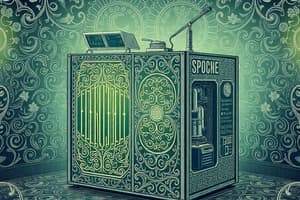Podcast
Questions and Answers
What is the primary function of a power supply?
What is the primary function of a power supply?
To convert AC input power line to DC output voltage.
Which component steps down high voltage AC mains to low voltage AC?
Which component steps down high voltage AC mains to low voltage AC?
- Rectifier
- Regulator
- Smoothing/Filter
- Transformer (correct)
What does a rectifier do?
What does a rectifier do?
- Smoothes DC output
- Converts AC to DC (correct)
- Steps down voltage
- Regulates voltage
Which type of rectifier circuit requires only one diode?
Which type of rectifier circuit requires only one diode?
What is the output of a full-wave bridge rectifier?
What is the output of a full-wave bridge rectifier?
A regulated power supply has a smooth DC output with no ripple.
A regulated power supply has a smooth DC output with no ripple.
What is a dual power supply?
What is a dual power supply?
What happens to the voltage used up in a bridge rectifier?
What happens to the voltage used up in a bridge rectifier?
Flashcards are hidden until you start studying
Study Notes
Power Supply Overview
- Acts as the core component of electronic devices, transforming AC power into DC output.
- Supplies the required voltage or current within circuits.
Power Supply Block Diagram
- Transformer: Reduces high voltage AC from mains to a lower voltage AC.
- Rectifier: Converts AC to DC; output is initially variable.
- Smoothing Filter: Minimizes variations in DC output, reducing ripple.
- Regulator: Stabilizes the DC output to maintain a fixed voltage.
Dual Power Supplies
- Designed for circuits needing both positive and negative outputs along with a zero voltage reference.
- Example: ±9V supply provides +9V, 0V, and -9V outputs.
Types of AC-DC Power Supply Rectifier Circuits
- Half-Wave Rectifier Circuit: Utilizes one diode for conduction during one half of the AC cycle.
- Full-Wave Center-Tapped Rectifier Circuit: Requires a center-tapped transformer and two diodes, each diode handling half the load current.
- Full-Wave Bridge Rectifier Circuit: Employs four diodes, eliminating the need for a center-tapped transformer. Capable of higher current output due to utilization of all AC cycles.
Output Characteristics of Power Supplies
- Transformer Only: Provides low voltage AC, suitable for lamps and heaters, inadequate for electronic circuits without rectification.
- Transformer + Rectifier: Produces varying DC, suitable for basic applications, but requires additional smoothing for electronic circuits.
- Transformer + Rectifier + Smoothing: Outputs smooth DC with minimal ripple, appropriate for most electronics.
- Transformer + Rectifier + Smoothing + Regulator: Delivers highly stable DC, ideal for all types of electronic circuits.
Rectifier Details
- Bridge rectifiers convert both halves of the AC wave into DC, marking the most efficient approach.
- Employs four diodes in configuration; two diodes conduct simultaneously, introducing a voltage drop of 1.4V.
- Rated by maximum current capacity and reverse voltage; should withstand peak voltages by being rated at least three times the RMS voltage.
Regulated Power Supplies
- Ensures consistent voltage output, crucial for sensitive electronic components.
- Design includes both foil patterns and wiring diagrams, aiding in the assembly and functional integrity of the power supply.
Studying That Suits You
Use AI to generate personalized quizzes and flashcards to suit your learning preferences.




